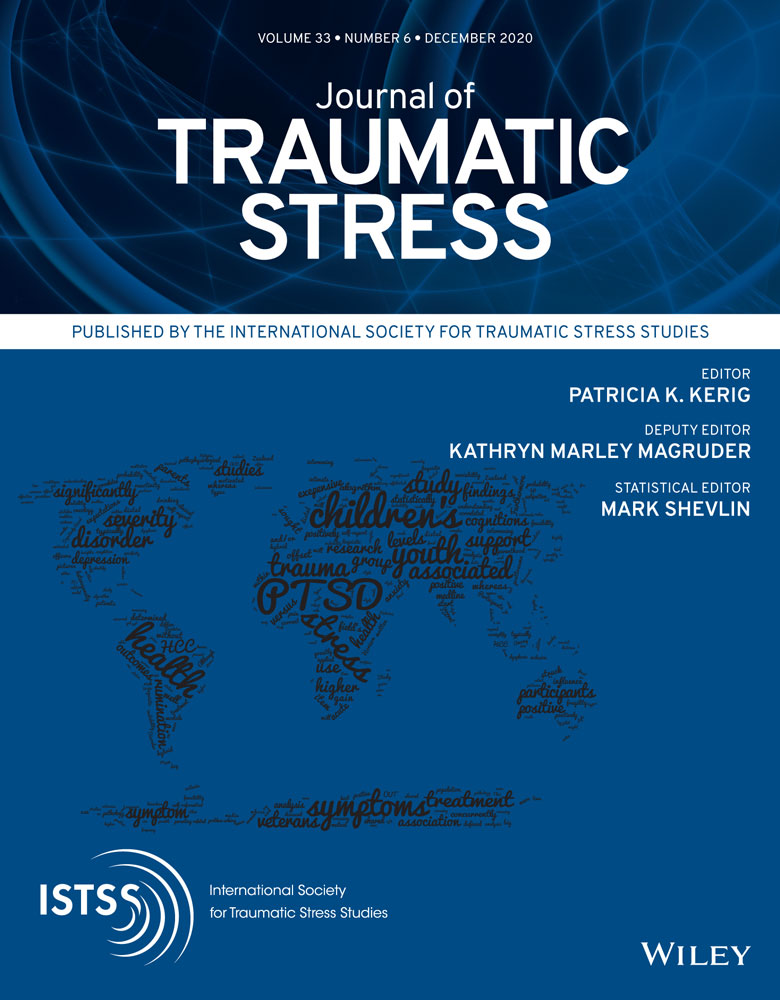Human Remains Identification, Grief, and Posttraumatic Stress in Bereaved Family Members 14 Years After the September 11, 2001, Terrorist Attacks
This research was supported by a grant secured by Voices of September 11th and was partially funded through Public Safety Canada's Kanishka Project Contribution Program. The research was conducted in partnership with Voices of September 11th, the Center for the Study of Traumatic Stress at the Uniformed Services University, and the Canadian Resource Centre for Victims of Crime.
The opinions and assertions expressed herein are those of the author(s) and do not necessarily reflect the official policy or position of the Uniformed Services University or the Department of Defense.
Abstract
enReturning human remains to family members after a loved one's death is thought to support grief adaptation. However, no known research has examined the effects that notifications of fragmented remains have on bereaved family members. We examined the number of notifications received, continuing questions about the death, grief severity, and posttraumatic stress (PTS) in family members bereaved by the September 11, 2001 attacks (N = 454). One notification was associated with fewer continuing questions compared to zero notifications, p = .037, or two or more notifications, p = .009. A model using notifications and continuing questions to predict grief severity showed there was no difference between receiving one and zero notifications, p = .244; however, receipt of two or more notifications was associated with higher grief severity compared to zero notifications, p = .032. A similar model demonstrated that receipt of any notifications was associated with PTS, ɳp2 = .026, p = .006. Having continuing questions was associated with grief severity, ɳp2 = .170, p < .001; and PTS, ɳp2 = .086, p < .001. Additionally, participants who received one notification and chose not to receive more had fewer continuing questions compared to all other participants, and participants who received two or more notifications and chose no future notifications had higher PTS levels compared to all other participants. The results indicate that human remains notification is not associated with reduced grief severity but is associated with PTS. These findings should inform notification policy and guide families’ notification choice after traumatic deaths.
Resumen
esSpanish Abstracts by Asociación Chilena de Estrés Traumático (ACET)
Restos humanos, duelo y estrés postraumático en familiares en duelo 14 años después del 11 de septiembre de 2001
RESTOS HUMANOS, DOLOR Y EPT 11/09
Se cree que devolver restos humanos a los miembros de la familia después de la muerte de un ser querido ayuda a adaptarse al duelo; sin embargo, ninguna investigación conocida ha examinado los efectos que tienen las notificaciones de restos fragmentados en los familiares en duelo. Examinamos el número de notificaciones recibidas, preguntas continuas sobre la muerte, la gravedad del duelo y el estrés postraumático (EPT) en miembros de la familia en duelo por los ataques del 11 de septiembre de 2001 (N = 454). Una notificación se asoció con menos preguntas continuas en comparación con cero notificaciones, p = .037, o dos o más notificaciones, p = .009. Un modelo que utilizó notificaciones y preguntas continuas para predecir el duelo mostró que no había diferencia entre recibir una notificación y ninguna, p = .244; sin embargo, la recepción de dos o más notificaciones se asoció con una mayor gravedad del duelo en comparación con cero notificaciones, p = .032. Un modelo similar demostró que la recepción de cualquier notificación estaba asociada con EPT, ɳp2 = .026, p = .006. Tener preguntas continuas se asoció con la gravedad del duelo, ɳp2 = .170, p <.001; y EPT, ɳp2 = .086, p <.001. Además, los participantes que recibieron una notificación y optaron por no recibir más tenían menos preguntas continuas en comparación con todos los demás participantes, y los participantes que recibieron dos o más notificaciones y no eligieron notificaciones futuras tuvieron niveles de EPT más altos en comparación con todos los demás participantes. Los resultados indican que la notificación de restos humanos no se asocia con una reducción de la gravedad del duelo, sino con el EPT. Estos hallazgos deben informar la política de notificación y guiar la elección de notificación de las familias después de muertes traumáticas.
抽象
zh簡體及繁體中文撮要由亞洲創傷心理研究學會翻譯
JOTS-19-0162.R3 Cozza
Human Remains, Grief, and Posttraumatic Stress in Bereaved Family Members 14 Years After September 11, 2001
Traditional Chinese
標題: 檢視於2001年9月11日喪親的人, 14年後其創傷後壓力、悲傷跟死者遺骸的關係
撮要: 將過世親屬遺骸歸還至其家屬, 被認為能支援喪親悲傷適應;然而, 目前並未有研究, 檢視被告知遺骸不完整對喪親家屬之影響。我們檢視在2001年9月11日之襲擊中喪失親屬的人 (n = 454) , 其收到的通知數量, 及其對喪事、悲傷嚴重度和創傷後壓力 (PTS) 的持續疑問。與收到零通知(p = .037) 或兩個以上的通知(p = .009) 相比, 收到一個通知跟有較少持續疑問相關。一個利用通知及持續疑問來預測喪親悲傷的模型顯示, 收到一個通知與零通知並沒有差別(p = .244);但收到兩個通知或以上, 相比收到零通知(p = .032), 跟悲傷嚴重度較高有關。一個類似的模型顯示, 只要收到任何通知, 都與PTS有關 (ɳP2 = .026, p = .006) 。持續有疑問跟悲傷嚴重度 (ɳP2 = .170, p <.001) 及PTS (ɳP2 = .086, p <.001) 有關。此外, 收到一個通知並選擇不再接受更多通知的樣本, 與所有其他樣本相比, 有較少持續疑問;而收到兩個或以上通知並選擇不再接受更多通知的樣本, 與所有其他樣本相比, 有更高的PTS水平。結果表明, 遺骸通知與喪親悲傷嚴重度減輕無關, 但與PTS有關。這些調查結果, 對有關創傷死亡之通知政策, 及為親屬作通知選項抉擇時提供指引, 應該有用。
Simplified Chinese
标题: 检视于2001年9月11日丧亲的人, 14年后其创伤后压力、悲伤跟死者遗骸的关系
撮要: 将过世亲属遗骸归还至其家属, 被认为能支持丧亲悲伤适应;然而, 目前并未有研究, 检视被告知遗骸不完整对丧亲家属之影响。我们检视在2001年9月11日之袭击中丧失亲属的人 (n = 454) , 其收到的通知数量, 及其对丧事、悲伤严重度和创伤后压力 (PTS) 的持续疑问。与收到零通知(p = .037) 或两个以上的通知(p = .009) 相比, 收到一个通知跟有较少持续疑问相关。一个利用通知及持续疑问来预测丧亲悲伤的模型显示, 收到一个通知与零通知并没有差别(p = .244);但收到两个通知或以上, 相比收到零通知(p = .032), 跟悲伤严重度较高有关。一个类似的模型显示, 只要收到任何通知, 都与PTS有关 (ɳP2 = .026, p = .006) 。持续有疑问跟悲伤严重度 (ɳP2 = .170, p <.001) 及PTS (ɳP2 = .086, p <.001) 有关。此外, 收到一个通知并选择不再接受更多通知的样本, 与所有其他样本相比, 有较少持续疑问;而收到两个或以上通知并选择不再接受更多通知的样本, 与所有其他样本相比, 有更高的PTS水平。结果表明, 遗骸通知与丧亲悲伤严重度减轻无关, 但与PTS有关。这些调查结果, 对有关创伤死亡之通知政策, 及为亲属作通知选项抉择时提供指引, 应该有用。




